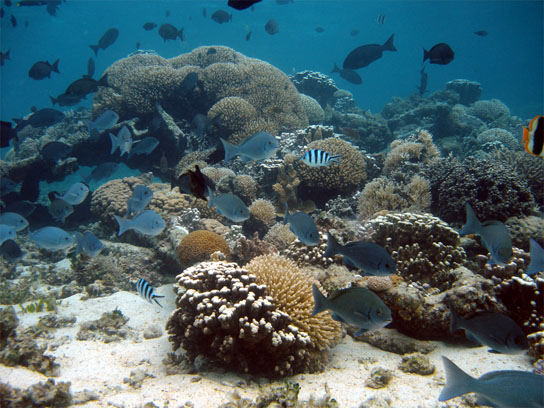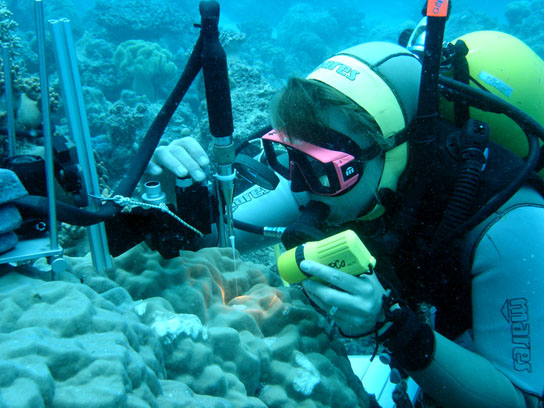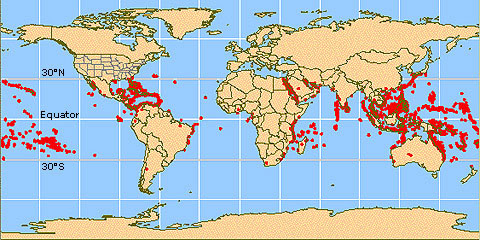Oxygen Depletion and Acidification Accelerate Coral Death
May 23, 2012

Three different reef-building corals in coastal waters of the Great Barrier Reef, Australia. They are smothered by terrigenous sediment, which was imported by rivers to the coral reefs. M. Weber/HYDRA Institute/Max Planck Institute for Marine Microbiology
Most people are fascinated by the colorful and exotic coral reefs, which form habitats with probably the largest biodiversity. But human civilization is the top danger to these fragile ecosystems through climate change, oxygen depletion and ocean acidification. Industrialization, deforestation and intensive farming in coastal areas are changing dramatically the conditions for life in the oceans. Now scientists at the Max Planck Institute for Marine Microbiology from Bremen together with their colleagues from Australia, Sultanate of Oman and Italy have investigated how and why the corals die when exposed to sedimentation. According to their findings, oxygen depletion, together with an acidification of the environment, creates a chain reaction that leads to coral death.
Reef forming stone corals inhabit the light-flooded tropical shallow coastal regions 30 degree south and north of the equator. Coral polyps build the carbonate skeletons that form the extensive reefs over hundreds to thousands of years. Photosynthesis of the symbiotic algae inside the polyps produces oxygen and carbohydrates from carbon dioxide and water, thereby feeding the polyps.
Since the 1980s the process of coral bleaching is under study: elevated temperatures of 1 to 3 degrees induce the algae to produce toxins. The polyps react by expelling the algae and the coral reef loses its color as if it was bleached. Without its symbionts the coral can survive only several weeks.
In coastal areas with excessive soil erosion where rivers flush nutrients, organics and sediments to the sea, corals can die quickly when exposed to sedimentation. Miriam Weber, scientist at the Max Planck Institute for Marine Microbiology in Bremen, explains the scientific approach.”Our idea was that a combination of enhanced deposition of sediments with elevated organic matter load and naturally occurring microorganisms can cause the sudden coral death. To get a handle on the diverse physical, chemical and biological parameters we performed our experiments at the Australian Institute for Marine Science (AIMS) in Townsville under controlled conditions in large containers (mesocosms), mimicking the natural habitat.”

Miriam Weber measures the oxygen concentration with hair-fine microsensors in a sediment layer, where the sediment was accumulated. If the organic load is increased in the two millimeter layer of sediments, the killing process will start. Blocked off from the light the algae will stop producing oxygen, microorganisms will start to decompose the organic matter, hydrogen sulfide is produced and kills the remaining cells. Lott/HYDRA Institute/Max Planck Institute for Marine Microbiology
- Phase 1: When a two millimeter layer of sediment enriched with organic compounds covers the corals, the algae will stop photosynthesis, as the light is blocked.
- Phase 2: If the sediments are organically enriched, then digestion of the organic material by microbial activity reduces oxygen concentrations underneath the sediment film to zero. Other microbes take over digesting larger carbon compounds via fermentation and hydrolysis thereby lowering the pH.
- Phase 3: Lack of oxygen and acidic conditions harm small areas of coral tissue irreversibly. The dead material is digested by microbes producing hydrogen sulfide, a compound that is highly toxic for the remaining corals. The process gains momentum and the remainder of the sediment-covered coral surface is killed in less than 24 hours.

Worldwide coral reefs occur between 30°N and 30°E. 15% of the world polupation depends directly of the well-beeing of coral reefs. NOAA
Source: Max Planck Institute
Images: M. Weber/HYDRA Institute/Max Planck Institute for Marine Microbiology; Lott/HYDRA Institute/Max Planck Institute for Marine Microbiology; NOAA
No comments:
Post a Comment